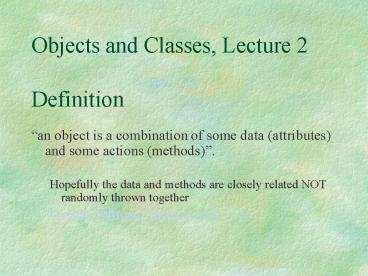Objects and Classes, Lecture 2 Definition - PowerPoint PPT Presentation
1 / 9
Title:
Objects and Classes, Lecture 2 Definition
Description:
Objects and Classes, Lecture 2 Definition an object is a combination of some data (attributes) and some actions (methods) . Hopefully the data and methods are ... – PowerPoint PPT presentation
Number of Views:36
Avg rating:3.0/5.0
Title: Objects and Classes, Lecture 2 Definition
1
Objects and Classes, Lecture 2Definition
- an object is a combination of some data
(attributes) and some actions (methods). - Hopefully the data and methods are closely
related NOT randomly thrown together - Creating Software Objects in Java
2
Example of an object
- A Ball Could have
- Attributes
xPosition, yPosition -
diameter, colour -
graphics context - Constructor
- Methods display
- changeXPosition, changeYPosition
- moveXPosition, moveXPosition,
- slowMoveXPosition,
- slowMoveYPosition
(xPosition, yPosition)
diameter
3
Classes
- Java provides many of its own classes.BUT for
something like a Ball, a Triangle etc, the
programmer must define what a ball or triangle
is ( ie what it looks like) - A class is like a template and an instance is
an object constructed from this template. - Constructor a special method used to create or
construct an object, most often used to
initialize variables So whats so special
about it Same name as class, never returns a
value.
4
- //shortened version of class
- public class Ball
- //attributes
- private int xPosition
- private int yPosition
- private int diameter
- private Color col
- private Graphics g
- //constructor
- public Ball(int xPosIn, int yPosIn, int diamIn,
- Color colIn, Graphics gIn)
- //public method headers or signatures
- public void display()
- public void changeXPosition(int xPosIn)
- public void changeYPosition(int yPosIn)
- public void moveXPosition(int xMove)
- public void moveYPosition(int yMove)
5
public or private
- If private, the programmer has control,
- that is no-one outside the class can see, ie
directly change the variables. - It is usual to make attributes private and write
public methods to enable necessary changes - This is Encapsulation or information hiding
6
- The constructor methods are made public so they
can be seen, ie used from a different class, any
private methods cannot be used from a different
class. - pinkBall new Ball(50,100,20,Color.pink,g)
diameter
xPosition
yPosition
colour
Graphics object
7
Creating Multiple Instances?
- // declare
- Ball orangeBall, pinkBall
- //construct
- orangeBall new
- Ball(20,40,30,Color.orange,g)
- pinkBall new
- Ball(50,100,20,Color.pink,g)
- //as many balls as you want/need all instances
or objects
8
- A second class CreateTwoBalls which extends
Applet, is used to construct, display and
manipulate the Ball objects by using their
methods - pinkBall.moveXPosition(50)
- pinkBall.moveYPosition(40)
- pinkBall.slowMoveXPosition(80)
9
Class CreateTwoBalls (three main objects)
- 1. User interface object created from the class
CreateTwoBalls . This is created by the browser
or AppletViewer. - 2. Ball objects, orangeBall and pinkBall, created
from the class Ball. These are created by the
user interface object of CreateTwoBalls .































